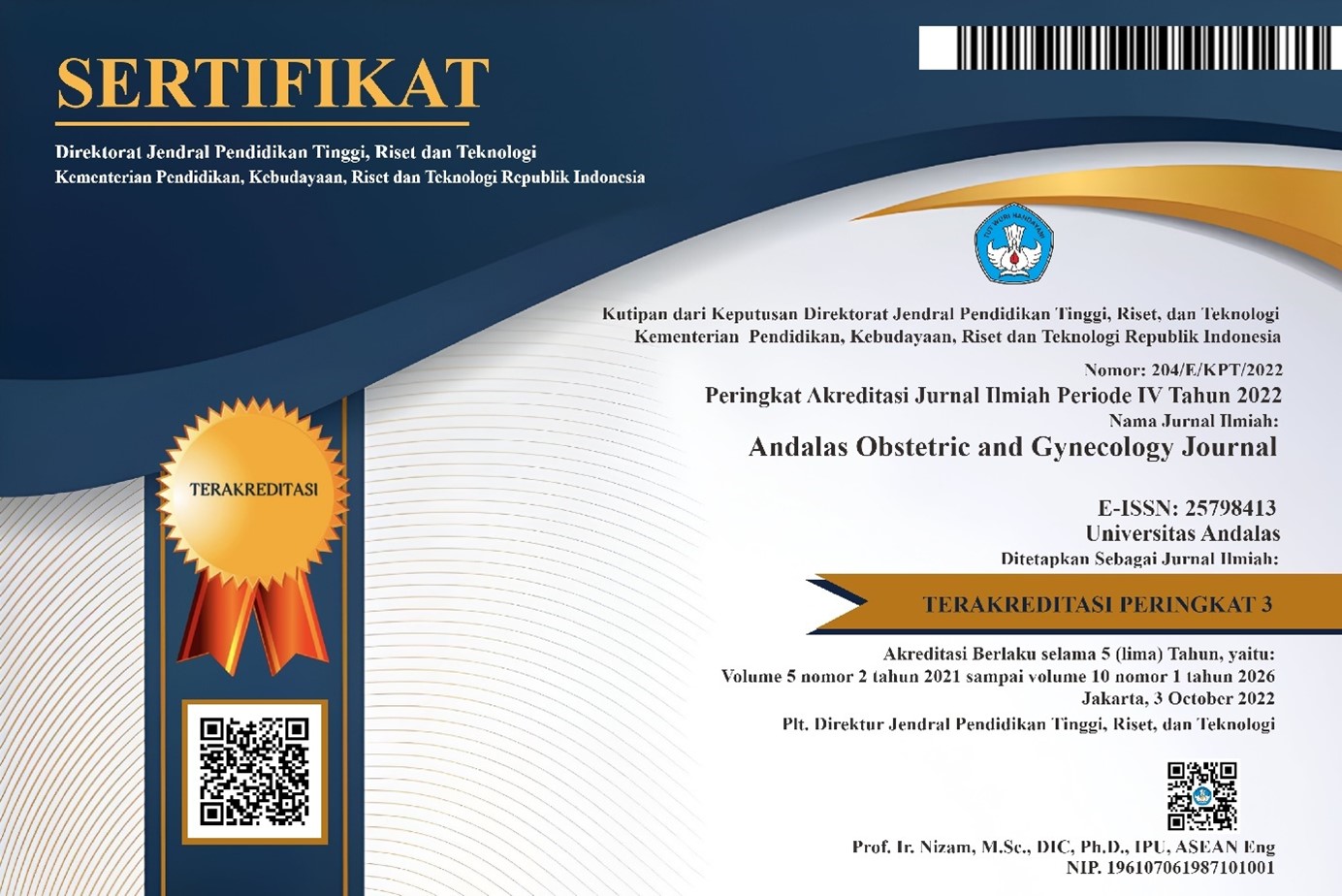Relationship Between Age, Parity, Employment, and Body Mass Index with The Event of The Hip Organ Prolapse Based on The Pelvic Organ Prolapse Quantification Score
DOI:
https://doi.org/10.25077/aoj.2.1.37-43.2018Abstract
Pelvic organ prolapse is a condition that affects the quality of women life. Pelvic organ prolapse can be caused by injury until the birth process, the aging process, the composition of the tissue in a woman, a chronic cough, or often do heavy work. Early detection of prolapse associated with Prognosis of anatomy and functional pelvic organs recovery. So we need training and learning more about Pelvic Organ Prolapse Quantification (POPQ) are clearly. The study was conducted by the method of case control study in the department of OB polyclinic of Dr. M. Djamil Padang Hospital from September 2013 until the total sample of 98 patients with 49 control groups and 49 in the case group. Analyzes were connected to assess the association of age, parity, occupation and body mass index with the incidence of pelvic organs prolapse based on POPQ. Score data are presented in tabular form. Data were tested by t-test and chi square test. If p <0.05 indicates significant results. There is a significant relationship between age and the incidence of pelvic organ prolapse (p <0.05) and OR 27,871. there is a significant correlation between parity and the incidence of pelvic organ prolapse (p<0.05) and OR 52,970. From the statistical analysis of the work, it cannot be tested statistically. From the body mass index, there is no significant relationship to the occurrence of pelvic organ prolapse (P> 0.05) and OR 1:00.
Keywords: age, parity, occupation, body mass index, pelvic organs prolapseReferences
Rizkar M. Prolap uteri. Dalam, Buku Ajar Uroginekologi Indonesia, Junizaf Santoso BI (editor). Himpunan Uroginekologi Indonesia Bagian Obstetri Ginekologi FKUI, Juni 2011; 29-37.
Schorge O, Schaffer JI, Cunningham
F. Pelvic Organ Prolapse. In William’s Gynecology, Tenth Edition. The McGraw- Hill Companies, 2008.
Irwanto EG. Diagnosis prolap organ pelvis yang berkunjung ke poliklinik Ginekologi RSUP Dr.M.Djamil Padang. PIT, 2009.
Richard S, Bercik M. Female Urinary Disorders & Pelvic Organ Prolapse. Departement of Obstetric,Gynaecology & Reproductive Science, 2006.
Bent AE. Ostergard’ s Urogynecology and pelvic floor dysfunction 5th ed. Lippincot, William & Wilkins, 2003.
Swift S. 2005. Physical Exam and Assessment of Pelvic Support Defects In Female Urology, Urogynecology, and Voiding Dysfunction by Marcel Dekker, Vasavada SP (eds), 2005; 520-529.
Kim CM. Risk factor for pelvic organ prolapsed. International Journal of Gynecology and Obstetrics, 2007; 98: 248- 251.
Muir TW. Adoption of the pelvic organ prolapse quantification system in pee- reviewed literature. Am J Obstet Gynecol, 2003; 189: 1632 -6
Hendrix SL, Clark A, Nygaard I. Pelvic organ prolapse in the Women’s Health Initiative: gravity and gravidity. Am J Obstet Gynecol, 2002; 186(6): 1160-6.
Tegerstedt G. 2006 Obstetric risk factor for symptomatic prolapse: A Population-based approach. American Journal of Obstetrics and Gynecology, 2006; 194: 75-81.
Dietz HP, Wilson PD. Childbirth and pelvic floor trauma. Best practice and research clinical obstetrics and gynaecology, 2005; 19(6): 913-924.
Swift S. 2005. Physical Exam and Assessment of Pelvic Support Defects. In Female Urology, Urogynecology, and Voiding Dysfunction by Marcel Dekker, Vasavada SP (eds), 2005; 520-529.
Nygaard I. Pelvic organ prolapsed in older women: prevalence and risk factor. Obstet Gynecol, 2004; 104: 489-97.
Washington BB. 2010. The association between obesity and stage II or greater prolapse. Am J Obstet Gynecol, 2010; 202: 1-4.
Downloads
Published
Issue
Section
License
Copyright (c) 2018 JOURNAL OBGIN EMAS

This work is licensed under a Creative Commons Attribution 4.0 International License.
Copyright
Authors who publish with this journal agree to the following terms:
- Authors retain the copyright of published articles and grant the journal right of first publication with the work simultaneously licensed under a Creative Commons Attribution 4.0 International License that allows others to share the work with an acknowledgment of the work's authorship and initial publication in this journal.
- Authors are able to enter into separate, additional contractual arrangements for the non-exclusive distribution of the journal's published version of the work (e.g., post it to an institutional repository or publish it in a book), with an acknowledgment of its initial publication in this journal.
- Authors are permitted and encouraged to post their work online (e.g., in institutional repositories or on their website) prior to and during the submission process, as it can lead to productive exchanges, as well as earlier and greater citation of published work (See The Effect of Open Access).
License:
Andalas Obstetrics and Gynecology Journal (AOJ) is published under the terms of the Creative Commons Attribution 4.0 International License. This license permits anyone to copy and redistribute this material in any form or format, compose, modify, and make derivatives of this material for any purpose, including commercial purposes, as long as they credit the author for the original work.







